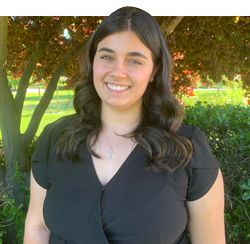
Having traveled throughout California, it’s no secret that the state is home to almost every commodity under the sun. In the Central Valley there are almonds and cows, produce out on the coast, and cattle in the mountain ranges. The diverse landscape and unique climate areas have built the state to be the largest contributor to the nation’s agricultural industry.

With different commodities being produced and processed, it calls for a major opportunity in the sustainability sector of the dairy industry. In California, almost 40% of a dairy cow’s diet is comprised of by-products, which means they can reduce, reuse, and recycle the food that we can’t eat into a delicious and nutritious product that ends up on our dinner table. For California dairy farms, this by-product fun fact means that feed rations are getting extremely creative.
Being the leading almond producing state in the country, almond by-products can be found all throughout a dairy farm. Almonds have two casings, also known as layers, before reaching the “meat” of an almond. The outermost layer is known as the hull, followed by the almond shell, and then the almond that we are able to eat. Due to the large number of almond producers and processors, these by-products are readily available for usage on dairies. The hull of the almond is a common ingredient in most California dairy farm feed rations, providing a relatively cheaper source of fiber in feeds. As for the almond shell, that’s what a cow’s bedding is mainly comprised of on almost every single California dairy. Just one commodity serves three separate uses, and dairy cows are able to take advantage of the parts of the almond that aren’t of use for humans.
Though, the list of by-products goes far beyond just almonds. I’ve visited dairy farms that use produce waste from grocery stores and the Salinas Valley, cottonseed from local processors, and even carrot waste from the Imperial Valley, which is home to the carrot capital of the world.

Feeding by-products in dairy cow feeds holds more than just a financial benefit. If not fed to cows, this leftover waste would instead end up in landfills and serve no purpose at all. The act of by-products sitting in the landfill is enough to elevate carbon emissions, seeing as though the carbon emissions for sending by-products to landfill is on average 60% greater than feeding them to cows. Cows have the unique ability to transform these useless ingredients into valuable nutrients that we can consume.
Having lived in the Midwest over a month now, I’ve become familiar with the rolling hills that are home to corn and soybeans. It’s no secret that every state in the nation has access to their own list of by-products, that can serve productive uses on their dairy farms. Whether it’s soybean meal or citrus pulp, cows are working everyday as the greatest upcyclers known to mankind.

Morgan Oliveira is the 2024 Hoard’s Dairyman editorial intern. She grew up working on her family’s dairy farm near Hilmar, Calif. As a student at Cal Poly University, Oliveira is majoring in agriculture communications.





